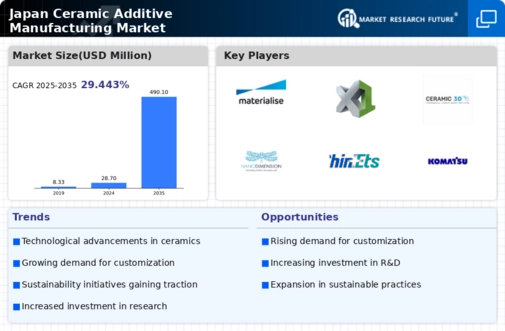The Japan Ceramic Additive Manufacturing Market is witnessing significant growth driven by advancements in technology and increasing demand for customized products across various industries, including aerospace, automotive, and healthcare. The competitive landscape is characterized by the presence of global and regional players who are continually innovating their offerings to meet the evolving needs of customers. Companies are focusing on enhancing their production capabilities, improving material quality, and optimizing design processes to gain a competitive edge.
The market's dynamics are shaped by factors such as technological advancements, regulatory frameworks, and collaborations among industry stakeholders, which play a crucial role in the strategic positioning of companies within this niche. Materialise has established a noteworthy presence in the Japan Ceramic Additive Manufacturing Market by leveraging its extensive experience in 3D printing and innovative software solutions. The company is recognized for its strong capabilities in software development and its ability to provide comprehensive support to customers through the entire additive manufacturing process.
Materialise's strengths lie in its advanced design and engineering tools, which facilitate the production of complex ceramic components with high accuracy and improved performance. Furthermore, the company emphasizes its commitment to research and development, ensuring it remains at the forefront of technological advancements in the industry. This focus on innovation has enabled Materialise to foster strong relationships with local manufacturers, enhancing its market presence and influence in Japan. ExOne, a prominent key player in the Japan Ceramic Additive Manufacturing Market, is known for its cutting-edge binder jetting technology that enables the production of high-quality ceramic parts.
The company offers a range of products and services tailored to meet the specific requirements of various industries, such as ceramics for prototyping, final parts, and customized solutions. ExOne has established a robust market presence through strategic partnerships and collaborations with local businesses, which has enhanced its competitive landscape. Its strengths are attributed to comprehensive technical support, efficient production processes, and a strong emphasis on quality control. Additionally, ExOne has pursued mergers and acquisitions to expand its capabilities and reach within the Japanese market, positioning itself effectively against competitors.
This consolidation of resources has allowed the company to strengthen its service offerings and enhance its overall market strategy in Japan, setting a strong foundation for future growth.





















